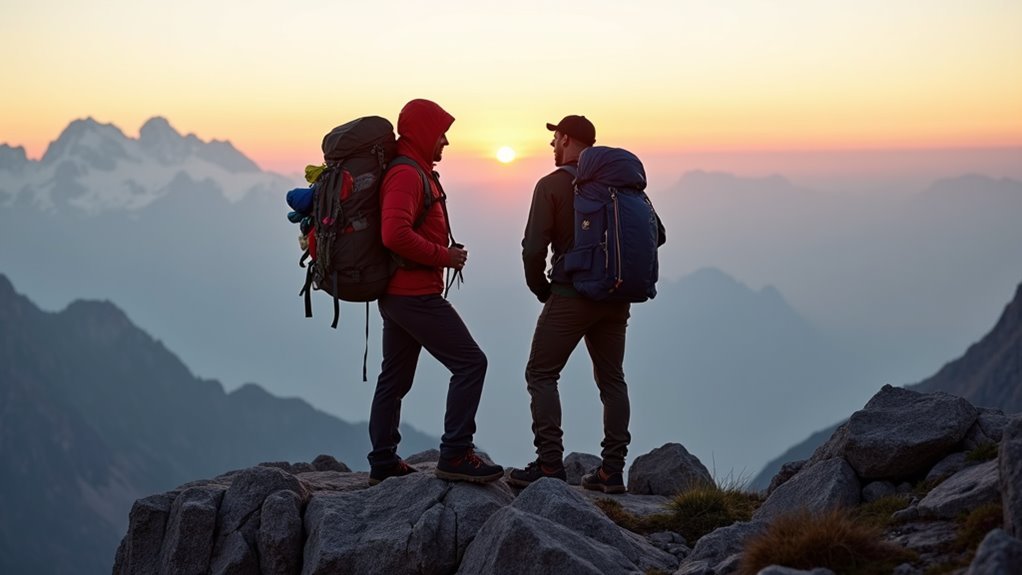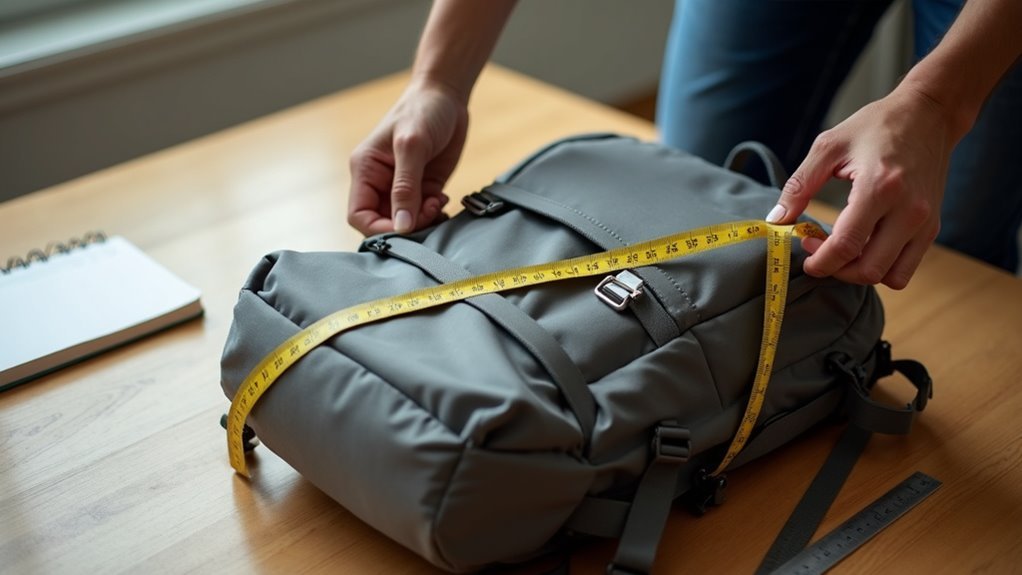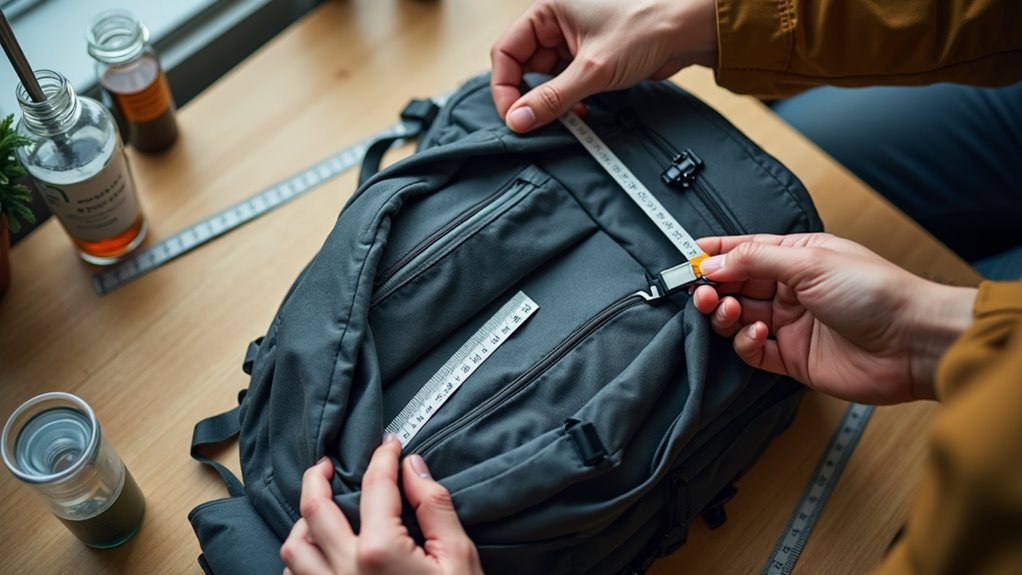I’ll be honest—measuring backpack volume accurately changed how I pack completely. You’ll need a flexible tape measure and perhaps some foam blocks for irregular shapes, though I think the setup matters more than fancy tools. Measure height from bottom to top of the main compartment, then width at the widest point, followed by depth from front to back. Multiply these dimensions and divide by 1,000 to convert cubic centimeters to liters. There’s more to mastering this skill than basic calculations.
Why Backpack Volume Matters More Than You Think

You’d think choosing a backpack would be straightforward – bigger is better, right? Wrong.
I’ve learned that volume is like the foundation of your entire packing strategy. It determines whether you’re cramming gear into every corner or traveling with breathing room.
Here’s what surprised me: two 40-liter packs can feel completely different. One might swallow your sleeping bag effortlessly while another leaves you wrestling with zippers.
The issue isn’t just about space – it’s about usable space. Perhaps more importantly, understanding volume helps you avoid that sinking feeling when your gear simply won’t fit.
Essential Tools and Setup for Accurate Measurements
Five basic tools will transform your volume measurement from guesswork into precision, though I’ll admit the setup feels almost too simple at first.
Simple tools and proper setup can eliminate the guesswork from backpack volume measurement once and for all.
You’ll need a flexible tape measure, calculator or smartphone app, flat surface, and perhaps some foam blocks for oddly shaped compartments.
I think the preparation matters more than the actual tools.
Place your backpack on that flat surface—a table works perfectly—then open all zippers completely.
Close external pockets though, since measuring them separately gives better accuracy.
The foam blocks help fill rounded spaces that create dead zones in your calculations, making everything more precise.
Step-by-Step Guide to Measuring Standard Backpack Dimensions

Since most backpacks follow rectangular dimensions, I’ll walk you through the straightforward approach that works for probably 80% of packs out there.
First, I’ll set my pack upright on that flat surface.
Here’s my process:
- Measure height from bottom to top of main compartment
- Measure width across the widest point horizontally
- Measure depth from front panel to back panel
I think the trickiest part is getting consistent depth measurements—backpacks aren’t perfectly rigid boxes. Sometimes I’ll gently stuff the compartment to get its true shape, though perhaps that’s overkill.
These three numbers give me the foundation for calculating volume.
Converting Your Measurements to Liters Like a Pro
Once I’ve got those three measurements in centimeters, the math becomes surprisingly straightforward—though I’ll admit the conversion process tripped me up the first few times.
Getting the measurements is the easy part—it’s remembering how to convert cubic centimeters to liters that always makes me pause.
I simply multiply length × width × height to get cubic centimeters, then divide by 1,000 to convert to liters.
For example, that 50cm × 30cm × 20cm backpack equals 30,000 cubic centimeters, which becomes 30 liters after division.
It’s basically just moving a decimal point three places left, though I still double-check with my phone calculator because, well, math errors happen when you’re enthusiastic to hit the trails.
Advanced Techniques for Unusual Shapes and Complex Designs

When backpacks start looking more like geometric puzzles than simple rectangles, I’ll be honest—the standard length-width-height formula pretty much goes out the window.
These oddly-shaped packs need different approaches, and I’ve found a few methods that actually work:
- Water displacement method – Submerge in a tub and measure overflow
- Garbage bag technique – Fill with bags, then measure those separately
- Foam block filling – Pack with measured foam pieces to account for curves
Complex designs with multiple compartments make this trickier, perhaps frustratingly so.
I think the key is patience and accepting that you’ll get approximations rather than perfect measurements.
Understanding Manufacturer Specifications and Making Smart Comparisons
Although manufacturers love slapping volume numbers on their backpack tags, I’ve learned the hard way that these specifications aren’t nearly as straightforward as they appear.
Some brands measure only main compartments, while others include every tiny pocket and side pouch. I think this creates wildly misleading comparisons.
When I’m shopping, I’ve started ignoring those flashy volume claims entirely. Instead, I focus on what’s actually included in their measurements.
Does that 40L pack include the hip belt pockets? The lid compartment? Perhaps it’s just the main body, making it smaller than expected when fully loaded.
Frequently Asked Questions
How Often Should I Remeasure My Backpack as It Ages and Wears?
I’d remeasure your backpack annually or after major adventures where it’s heavily used. Wear affects fabric stretch and compression, changing actual capacity. Don’t let worn gear limit your freedom—stay informed about your pack’s true capabilities.
Does Backpack Material Thickness Affect the Actual Usable Internal Volume Significantly?
Ironically, while we obsess over precise measurements, material thickness absolutely steals usable space. I’ve seen thick canvas packs lose several liters compared to ultralight alternatives—your freedom demands every cubic inch.
Can I Use Smartphone Apps to Measure Backpack Volume Instead of Manual Methods?
I can use smartphone apps with AR measurement tools, but they’re less accurate than manual methods. Apps work best for quick estimates, though I’ll get more precise results using a tape measure and calculator for backpack volume calculations.
Should I Account for Compression When Calculating Volume for Sleeping Bags?
I don’t recommend accounting for compression when calculating sleeping bag volume because you’ll want to pack based on uncompressed size. Compression varies by conditions, and overestimating space leads to better packing decisions and gear freedom.
How Does Altitude Affect Backpack Volume Measurements During Mountain Expeditions?
At 18,000 feet, air pressure drops 50%, but your backpack’s physical volume won’t change. I’d measure at sea level since altitude affects your body’s needs more than gear capacity during expeditions.
Conclusion
You’ve now got the tools to measure any backpack accurately—no more guessing games or marketing disappointments. I think the water displacement method will probably become your go-to technique, though perhaps the traditional measuring approach works better for simpler designs. Why trust manufacturer specs when you can verify everything yourself? These skills transform shopping from hopeful gambling into informed decision-making. Your next adventure deserves a backpack that actually fits your gear, not just promises to.